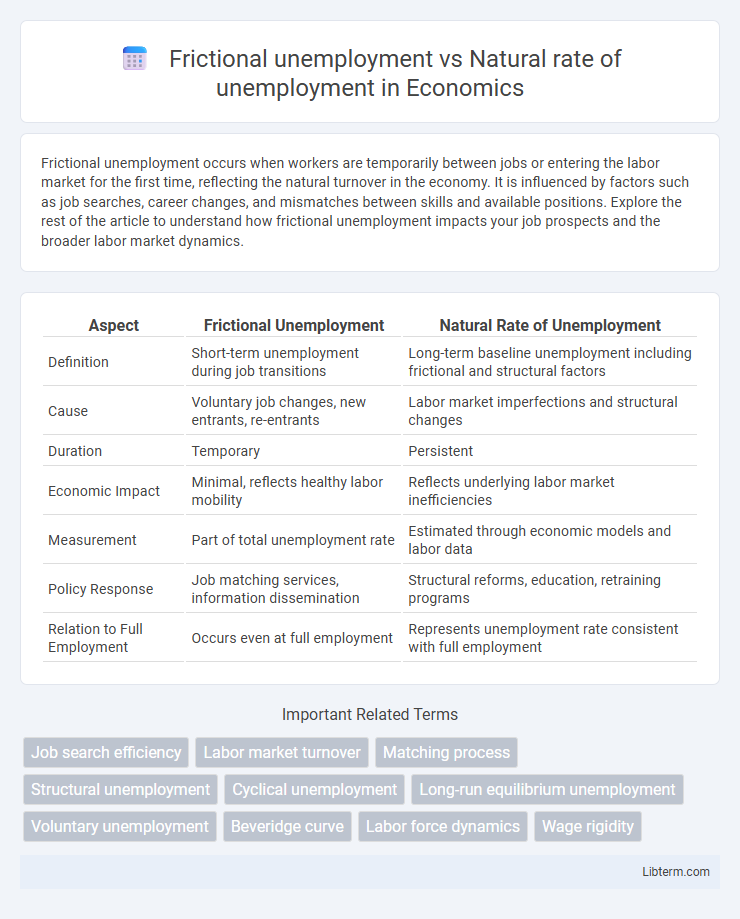Frictional unemployment occurs when workers are temporarily between jobs or entering the labor market for the first time, reflecting the natural turnover in the economy. It is influenced by factors such as job searches, career changes, and mismatches between skills and available positions. Explore the rest of the article to understand how frictional unemployment impacts your job prospects and the broader labor market dynamics.
Table of Comparison
| Aspect | Frictional Unemployment | Natural Rate of Unemployment |
|---|---|---|
| Definition | Short-term unemployment during job transitions | Long-term baseline unemployment including frictional and structural factors |
| Cause | Voluntary job changes, new entrants, re-entrants | Labor market imperfections and structural changes |
| Duration | Temporary | Persistent |
| Economic Impact | Minimal, reflects healthy labor mobility | Reflects underlying labor market inefficiencies |
| Measurement | Part of total unemployment rate | Estimated through economic models and labor data |
| Policy Response | Job matching services, information dissemination | Structural reforms, education, retraining programs |
| Relation to Full Employment | Occurs even at full employment | Represents unemployment rate consistent with full employment |
Introduction to Unemployment Types
Frictional unemployment occurs when workers are temporarily between jobs or searching for new opportunities, reflecting the normal job turnover in a healthy economy. The natural rate of unemployment includes frictional unemployment along with structural unemployment and represents the baseline level of unemployment achievable without causing inflation. Understanding these types helps differentiate short-term job transitions from more persistent labor market challenges.
Defining Frictional Unemployment
Frictional unemployment refers to the short-term joblessness experienced by individuals transitioning between jobs or entering the labor market for the first time, reflecting normal labor market turnover. It arises from factors like job search time, geographical mobility, and mismatches in job skills. This type of unemployment is a natural and unavoidable component of the natural rate of unemployment, which also includes structural unemployment but excludes cyclical unemployment caused by economic downturns.
Understanding the Natural Rate of Unemployment
The natural rate of unemployment represents the long-term average level of unemployment caused by structural and frictional factors in the labor market, independent of short-term economic fluctuations. Frictional unemployment specifically arises from the transitional period when workers are between jobs or entering the workforce, reflecting normal labor market dynamics. Understanding the natural rate helps policymakers distinguish between cyclical unemployment and the baseline unemployment rate that an economy can sustain without causing inflationary pressures.
Key Differences Between Frictional and Natural Unemployment
Frictional unemployment refers to temporary joblessness during transitions between jobs or entering the workforce, characterized by voluntary mobility and short durations. The natural rate of unemployment encompasses frictional unemployment along with structural unemployment, representing the baseline level of unemployment when the economy is at full employment without cyclical fluctuations. Key differences include that frictional unemployment is always present due to normal labor market dynamics, whereas the natural rate incorporates all non-cyclical unemployment factors, providing a broader measure of labor market health.
Causes of Frictional Unemployment
Frictional unemployment arises from the transitional period when workers voluntarily leave jobs to find more suitable employment, reflecting the time needed for job search and matching skills with vacancies. Key causes include new entrants into the labor market, changes in career preferences, geographic mobility constraints, and imperfect information about job opportunities. This type of unemployment contrasts with the natural rate of unemployment, which encompasses frictional and structural unemployment as the long-term baseline employment level in a healthy economy.
Factors Influencing the Natural Rate of Unemployment
The natural rate of unemployment is influenced by factors such as labor market policies, unemployment benefits, and the efficiency of job matching processes, which affect the duration and frequency of frictional unemployment. Structural elements like technological changes, labor union activities, and demographic shifts also play critical roles in shaping the natural rate by altering the supply and demand dynamics within the labor market. Understanding these determinants helps distinguish frictional unemployment, arising from short-term job transitions, from the broader, long-term natural rate influenced by persistent labor market conditions.
Economic Implications of Both Unemployment Types
Frictional unemployment reflects short-term job transitions and indicates a dynamic labor market where workers search for better opportunities, often signaling economic mobility and flexibility. The natural rate of unemployment encompasses frictional, structural, and other unavoidable unemployment types, representing the baseline level consistent with a healthy economy without cyclical fluctuations. High frictional unemployment can imply effective job matching processes, whereas deviations from the natural rate often signal macroeconomic imbalances requiring policy intervention to stabilize growth and inflation.
How Policy Makers Address Frictional Unemployment
Policy makers address frictional unemployment primarily through improving labor market information systems, facilitating more efficient job matching between employers and workers. Initiatives like job search assistance programs, vocational training, and enhanced unemployment benefits that encourage active job searching reduce the duration of frictional unemployment. By streamlining the transition process, these policies help maintain the natural rate of unemployment at an optimal level that reflects healthy labor market turnover.
Strategies to Manage the Natural Rate of Unemployment
Strategies to manage the natural rate of unemployment focus on improving labor market efficiency and enhancing worker skills through targeted education and training programs, enabling quicker job matching and reducing structural mismatches. Implementing active labor market policies such as job search assistance, unemployment benefits linked to job-seeking behavior, and flexible labor regulations helps lower frictional unemployment while maintaining healthy job turnover. Investment in technology and infrastructure also supports job creation in emerging sectors, ultimately contributing to a lower natural rate of unemployment.
Conclusion: Balancing Frictional and Natural Unemployment
Frictional unemployment represents short-term job transitions, reflecting healthy labor market dynamics, while the natural rate of unemployment includes frictional, structural, and seasonal factors, serving as an economy's baseline unemployment level. Achieving balance requires policies that enhance job matching efficiency and skill development to reduce frictional unemployment without pushing the overall rate below natural levels. Maintaining this equilibrium supports sustainable economic growth by minimizing joblessness without triggering inflationary pressures.
Frictional unemployment Infographic

 libterm.com
libterm.com